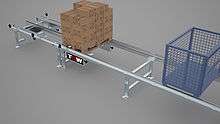Chain conveyor

A chain conveyor is a type of conveyor system for moving material through production lines.
Chain conveyors utilize a powered continuous chain arrangement, carrying a series of single pendants. The chain arrangement is driven by a motor, and the material suspended on the pendants are conveyed. Chain conveyors are used for moving products down an assembly line and/or around a manufacturing or warehousing facility.
Chain conveyors are primarily used to transport heavy unit loads, e.g. pallets, grid boxes, and industrial containers. These conveyors can be single or double chain strand in configuration. The load is positioned on the chains, the friction pulls the load forward.[1] Chain conveyors are generally easy to install and have very minimum maintenance for users.
Many industry sectors use chain conveyor technology in their production lines. The automotive industry commonly uses chain conveyor systems to convey car parts through paint plants.[2] Chain conveyors also have widespread use in the white and brown goods, metal finishing and distribution industries. Chain conveyors are also used in the painting and coating industry, this allows for easier paint application. The products are attached to an above head chain conveyor, keeping products off of the floor allows for higher productivity levels.
Multiflexing chain conveyor
The multiflexing conveyor systems use the plastic chains in many configurations. The flexible conveyor chain design permits horizontal as well as vertical change of direction.

Drag chain conveyor
The drag chain conveyor system, used for dry bulk solids and powder processing, moves powders and granules, particularly fragile materials such as cereals, nuts, coffee beans and food ingredients inside a hygienic, sealed tube. Material is fed into the pockets formed between discs inside of the conveying tube and is pulled through until it reaches the outlet. This is important particularly for food products as it minimizes product degradation and ensures dust-free transfer.[3]
See also
References
- ↑ http://www.mhia.org/learning/glossary/c
- ↑ Mitchel, Philip (1998). Tool and Manufacturing Engineers Handbook: Material and Part Handling in Manufacturing. Society of Manufacturing Engineers. pp. 9-12–9-18. ISBN 9780872634893.
- ↑ "Chainflow Drag Chain Conveyors | Hygienic, Dust Free & Enclosed". Spiroflow. Retrieved 2018-04-24.
- Tsubakimoto Chain Co., ed. (1997). The Complete Guide to Chain. Kogyo Chosaki Publishing Co., Ltd. p. 240. ISBN 0-9658932-0-0. Retrieved 16 July 2008.
| Wikiquote has quotations related to: Chain conveyor |